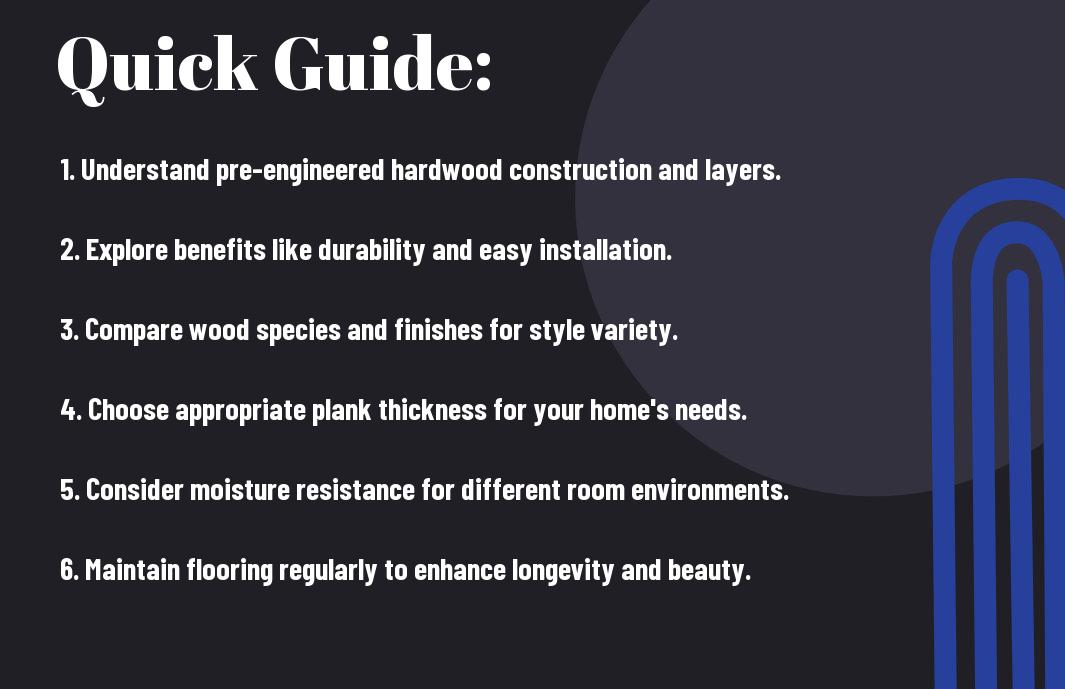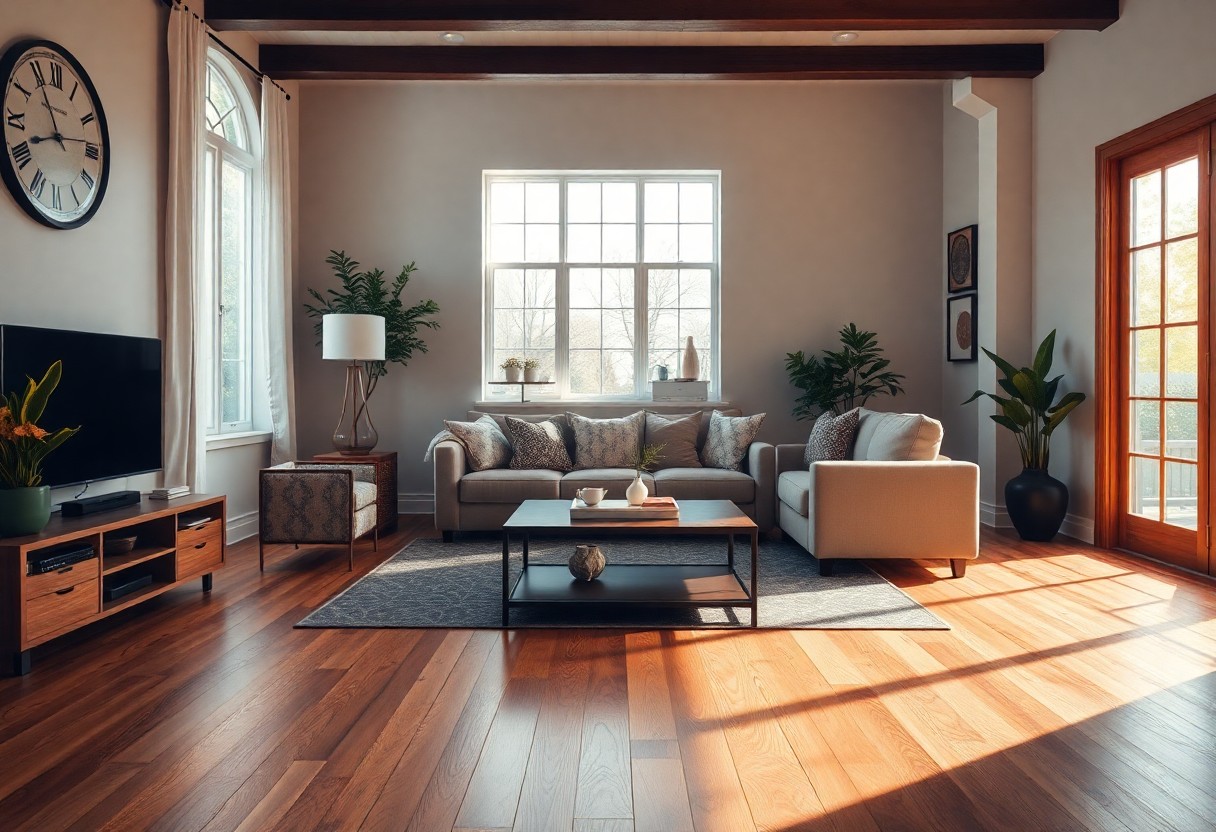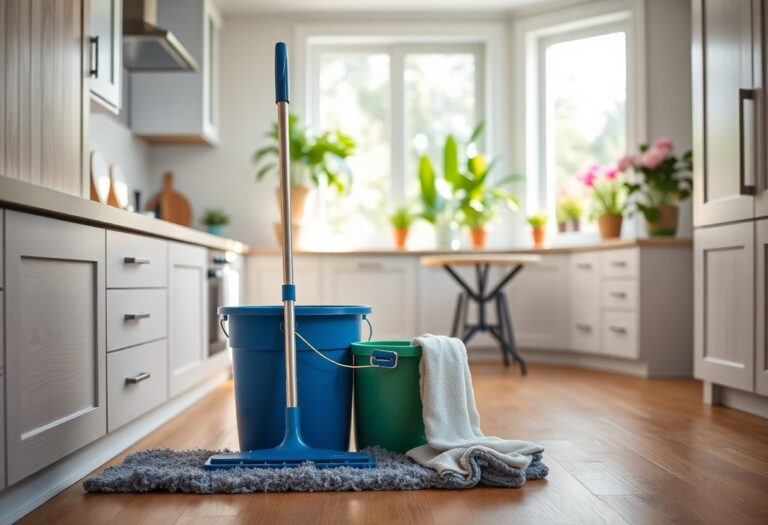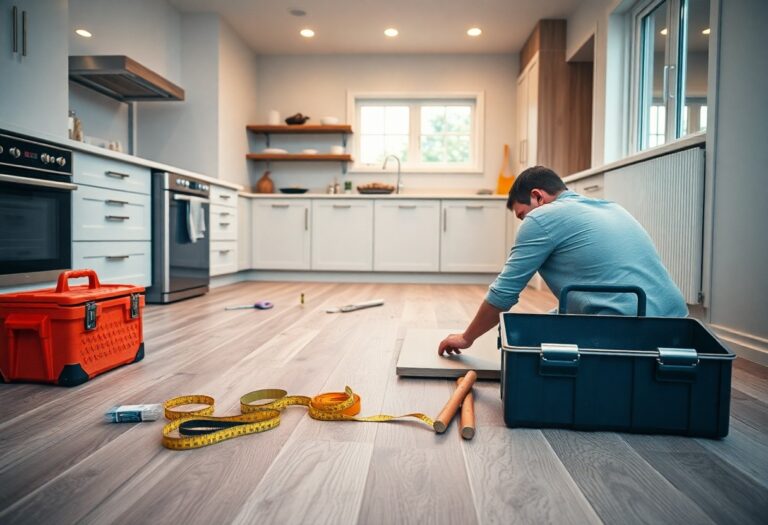Over the years, pre-engineered hardwood has gained popularity among homeowners seeking a stylish yet practical flooring solution. This comprehensive guide will explore the myriad benefits of pre-engineered hardwood, including its durability, ease of installation, and aesthetic appeal. You’ll also discover various choices available to fit your unique taste and lifestyle. Whether you’re renovating or building a new home, understanding these aspects will help you make informed decisions for your flooring needs.

Understanding Pre-Engineered Hardwood
To fully appreciate pre-engineered hardwood, it is vital to grasp its structure and versatility. This flooring option is constructed with multiple layers, combining a solid hardwood veneer with high-density plywood, offering enhanced stability and durability. It caters to your varying needs, making it suitable for any room in your home, ensuring both aesthetic appeal and practicality.
What is Pre-Engineered Hardwood?
Hardwood floors are a popular choice in many homes, but pre-engineered hardwood stands out due to its unique construction. It features a top layer of genuine hardwood, backed by layers of plywood or composite materials that provide stability and resistance to moisture. This design allows you to enjoy the beauty of hardwood while extending its longevity and usability.
Advantages Over Solid Hardwood
There’s no denying that pre-engineered hardwood offers several advantages over solid hardwood. Its layered construction grants it increased durability and stability, making it less susceptible to warping or cracking. Additionally, you can install it over various subfloors, including concrete, without the need for acclimation, making it a more convenient option for your home renovation projects.
The advantages of pre-engineered hardwood over solid hardwood extend beyond mere practicality. This type of flooring can handle fluctuations in temperature and humidity better, which is particularly beneficial if you live in a climate with significant seasonal changes. Moreover, its installation is often quicker and easier, allowing you to enjoy your new floors sooner. These factors make pre-engineered hardwood an excellent choice for enhancing your home’s aesthetic while ensuring long-lasting functionality.

Types of Pre-Engineered Hardwood
While exploring pre-engineered hardwood, you will find a variety of types that cater to different aesthetics and functional needs. Understanding these options will help you select the best choice for your home.
- Engineered Oak
- Engineered Maple
- Engineered Hickory
- Engineered Cherry
- Engineered Walnut
Any of these types can enhance your space while providing durability and stability.
| Type | Description |
| Engineered Oak | Highly durable and versatile, ideal for high-traffic areas. |
| Engineered Maple | Known for its smooth grain and light color, perfect for modern styles. |
| Engineered Hickory | Offers a rustic charm with distinct color variations. |
| Engineered Cherry | Features rich tones, deepening beautifully over time. |
| Engineered Walnut | Known for its dark, luxurious appearance and warmth. |
Common Wood Species
Types of pre-engineered hardwood commonly include popular wood species like oak, maple, hickory, cherry, and walnut. Each species comes with its unique characteristics, ensuring you can find the ideal match for your design preferences.
Different Finishes and Textures
To elevate the charm of your pre-engineered hardwood, you’ll find a wide range of finishes and textures available. Each finish contributes to the wood’s aesthetic and durability, enhancing its overall appearance.
With various finishes like matte, gloss, and satin, you can customize the look to complement your home’s decor. Textures such as hand-scraped, wire-brushed, or smooth also play a significant role in defining the character of your flooring. By selecting the appropriate combination, you can achieve the exact ambiance you desire in your living space.
Factors to Consider Before Choosing
Unlike traditional hardwood, pre-engineered hardwood offers unique advantages, but selecting the right option for your home requires careful consideration. Focus on the following factors:
- Room usage and foot traffic
- Your preferred aesthetic and style
- Moisture levels in your environment
- Maintenance requirements and ease
Perceiving these elements will help you make a well-informed decision that aligns with your needs.
Climate and Environment
While choosing your pre-engineered hardwood, consider your local climate and environmental conditions. The material is designed to withstand different moisture levels and temperature variations, but knowing how these factors affect the durability and performance of your flooring is necessary for long-term satisfaction.
Lifestyle and Usage
While assessing your lifestyle and usage patterns, think about how you and your family use each space in your home. Areas with high foot traffic, like living rooms or hallways, may require more durable options, while bedrooms can accommodate softer finishes.
Choosing the right pre-engineered hardwood requires you to reflect on how your daily activities impact flooring performance. If you have pets or children, opt for products with higher wear ratings that can withstand scratches and spills. Conversely, if you prefer a more aesthetic-focused approach for spaces with lighter activity, you may select options with beautiful finishes that enhance the beauty of your home without compromising on quality.
Pros and Cons of Pre-Engineered Hardwood
Despite its growing popularity, pre-engineered hardwood comes with both advantages and disadvantages. Understanding these can help you make an informed choice for your home.
Pros and Cons
| Pros | Cons |
|---|---|
| More affordable than solid wood | Can be susceptible to water damage |
| Easy installation | Limited refinishing options |
| Stable in varying humidity | Less authentic feel compared to solid wood |
| Variety of styles and finishes | May have a shorter lifespan than solid wood |
| Reduced environmental impact | Quality can vary by manufacturer |
Benefits of Installation
To make the installation process smoother, pre-engineered hardwood can be installed over various subfloors, including concrete, making it a versatile choice for different areas of your home. Additionally, its click-lock installation system allows for a quicker setup, minimizing the time needed for labor and disruption in your living space.
Potential Drawbacks
The disadvantages of pre-engineered hardwood can affect your long-term satisfaction with the flooring. While it offers many benefits, it’s important to consider how these drawbacks might impact your home.
For instance, although pre-engineered hardwood is more affordable, it may not withstand water exposure as well as solid wood, leading to potential issues in areas prone to moisture. Additionally, its limited refinishing opportunities mean that once the surface wears down, you may need to replace the flooring rather than restore it. This can result in higher long-term costs if you choose a low-quality product that doesn’t hold up over time.
Step-by-Step Installation Guide
Not all installations are the same, and that’s why following a step-by-step guide can help you achieve a seamless finish with your pre-engineered hardwood floors. You’ll want to ensure you have everything in place for a smooth process. Below is a simplified breakdown of the installation phases.
| Installation Phase | Description |
|---|---|
| Preparation | Gather tools and materials, and acclimate the flooring. |
| Layout | Plan your layout and make necessary measurements. |
| Installation | Commence laying down the planks according to the selected pattern. |
| Finishing Touches | Install trims, clean the area, and allow the floor to settle. |
Tools and Materials Needed
Installation requires a specific set of tools and materials to ensure a successful project. You’ll need vital tools such as a saw, measuring tape, and spacer blocks, alongside materials like underlayment and fasteners to complete the job effectively.
Installation Process Overview
One of the most important aspects of installing pre-engineered hardwood flooring is understanding the overall process. You will start with proper preparation, including acclimating the materials to your home environment. Next, you’ll meticulously plan the layout to make the most of your space, and finally, you will lay the planks according to your chosen design.
Installation should be approached methodically. After preparing your subfloor and selecting the ideal planks, place underlayment down to reduce sound and provide cushioning. As you begin laying the planks, ensure they fit tightly without gaps, maintaining a consistent pattern throughout. Finally, secure your trims and clean your new floor thoroughly to highlight your beautiful work.
Maintenance Tips for Longevity
All pre-engineered hardwood floors require regular care to maintain their beauty and extend their lifespan. Implement these key maintenance tips:
- Regularly sweep or vacuum to remove dirt and debris
- Use a damp mop with a gentle cleaner to prevent buildup
- Place mats at entryways to reduce wear from foot traffic
- Refinish every few years to restore the finish
- Avoid excessive moisture and direct sunlight exposure
After following these tips, you’ll enhance the longevity of your floors and keep them looking beautiful for years to come.
Regular Cleaning Practices
Little ongoing maintenance can make a significant difference in the appearance and durability of your pre-engineered hardwood floors. Aim to clean them regularly with a soft-bristle broom or vacuum to remove dirt and debris that may scratch the surface. Use a damp mop and/or a manufacturer-recommended cleaner to avoid damaging the finish, and don’t forget to clean up spills immediately to prevent moisture damage. Frequent cleaning will help preserve the wood’s natural beauty.
Repairing Scratches and Damage
Damage to your pre-engineered hardwood floors can happen, but you can manage it effectively. Start by assessing the severity of the scratch or dent and choose appropriate repair methods. For shallow scratches, a touch-up marker or wood filler can help mask the blemish, while deeper scratches might require sanding the affected area and refinishing it to return to its original appearance. In instances of significant damage, you may need to replace individual planks for a seamless look.
Scratches can detract from the elegance of your flooring, but with timely action, they can be effectively repaired. Begin by cleaning the area thoroughly to remove dust and debris. For minor scratches, apply a wood filler that matches your flooring color and smooth it out. If the scratch is deeper, lightly sand the area, and then reapply the finish to blend it in. Don’t hesitate to consult with a professional if the damage is extensive or if you’re unsure about tackling the repair yourself.
To wrap up
Summing up, the ultimate guide to pre-engineered hardwood ensures you have all the knowledge needed to make informed choices for your home. With its versatility, durability, and aesthetic appeal, pre-engineered hardwood offers a multitude of benefits tailored to your lifestyle and preferences. By considering factors like installation, maintenance, and design options, you can select the perfect flooring that enhances your space while adding value to your home. Embrace the possibilities and transform your living areas with the right choice of pre-engineered hardwood flooring.





